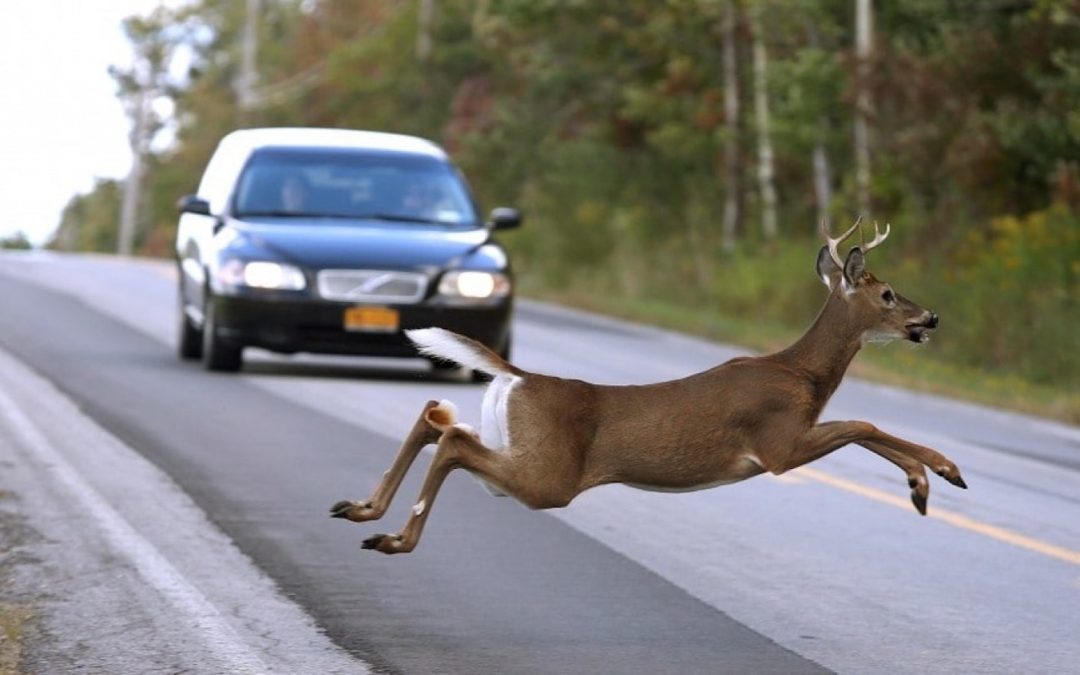DEER-VEHICLE COLLISIONS INCREASE IN THE FALL
Richland County, OH — Ohio drivers beware. Your risk of colliding with deer increases in October, according to officials at the Ohio Department of Public Safety (ODPS) and the Ohio State Highway Patrol (OSHP). The increased risk is partly due to the fact that October through December is peak deer mating season in the Buckeye state.
According to ODPS, 19,375 deer-vehicle (D-V) crashes were reported statewide last year, an increase of 1,066 over the deer crashes from 2018.
Four deaths and 885 injuries were caused by Ohio D-V crashes in 2019. The death is up one from 2018 but the injuries were down by 95. Not all D-V crashes are reported so the crash numbers are probably much higher.
Richland County was second among Ohio’s 88 counties for D-V crashes. The four counties with the highest number of reported D-V crashes in 2018 were Stark (511), Richland (510), Defiance (493), and Hancock (425).
“If there’s a ‘Deer Crossing’ sign, pay attention,” said Reed Richmond, Health Educator at Richland Public Health and an instructor in the AARP senior driver refresher classes. “Those signs are there because they are areas well known for high, and active, wildlife populations. Use extreme caution, especially during these fall months and especially at dawn (5-8 a.m.) and at dusk (6-9 p.m.). Since the deer don’t know any better, don’t think of it as a deer crossing the road. Think of it as the road crossing the forest.”
“If you see one deer beside the road, slow down,” Richmond says. “Deer typically travel in groups, so the appearance of one approaching or crossing a road or a highway often indicates others’ presence nearby.”
According to OSHP D-V crash data, November is the peak month for such collisions, representing nearly 23% of Ohio’s D-V crashes.
Richmond had his own D-V crash in late November of 2016. “It was not a pleasant experience,” he says, “but typical of these crashes. It was dusk in an area where deer are frequently seen and it was raining. It was sudden; I barely had time to hit my brakes.”
Should a collision appear imminent, OSHP authorities urge drivers not to swerve. Colliding with a deer is generally less hazardous than veering into opposing traffic or losing control and running off the road.
How to avoid hitting a deer*
- Know the time of day: Dusk and dawn are prime times for deer activity, especially the hours of
5-8 a.m. and 6-9 p.m., during the months of October-December. - Observe posted deer-crossing signs: Drive with extreme caution, at or below the posted speed limit, especially in areas where deer are prevalent.
- Don’t swerve: If a collision with a deer seems probable, hit it while maintaining full control of your vehicle. Brake firmly and stay in your lane. A sudden swerve increases the risk of hitting another car or overturn.
- Note: If you hit a deer in your path, you will not be ticketed. However, if you have a crash after swerving to avoid a deer, you may be cited for failure to control.
- Use your bright lights: After dark, use high beams when there’s no opposing traffic. High beams illuminate the eyes of deer on or near a roadway and provide greater motorist reaction time. Don’t rely solely on high beams to deter collisions.
- Expect more than one: If you see a deer on or near a roadway, expect others to follow.
- Wear your seat belt: As required by state law and drive at a safe, sensible speed for conditions.
- Stay alert: Deer are unpredictable and can dart out into traffic on busy highways.
- Don’t rely on deer avoidance devices: Deer whistles and special reflectors that are marketed to scare deer away are not proven to reduce collisions, and may lull you into a false sense of security.
Following a collision*
- Move your vehicle to a safe place: Preferably off the road and turn on your hazard lights.
- Contact law enforcement: For medical and traffic control assistance, if needed.
- Document the incident: Use your phone and take pictures of everything including injured animals, vehicle damage, other property damage and injuries sustained. Obtain contact info on witnesses.
- Don’t touch an injured animal: It may scare them and cause additional chance of injury.
- Don’t assume your vehicle is drivable: Check for fluid leaks, tire damage, broken lights, heavy damage to the hood or front end, etc. If in doubt, call for a tow truck.
- Report the D-V collision to a local law enforcement agency: Such as OSHP, within 24 hours. Road-killed deer may only be possessed by receipt or permit. If you pick up a deer, you can contact a state wildlife officer, sheriff’s office or the OSHP for a receipt. (see Ohio Revised Code 121: Deer killed by motor vehicle on highway)
- Contact your company or insurance agent: If you plan to file a comprehensive claim.
*Portions from Ohio Department of Public Safety

